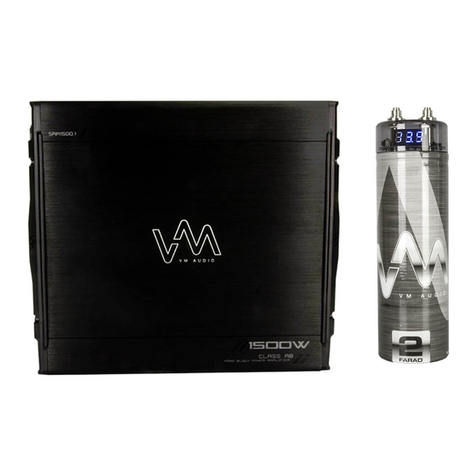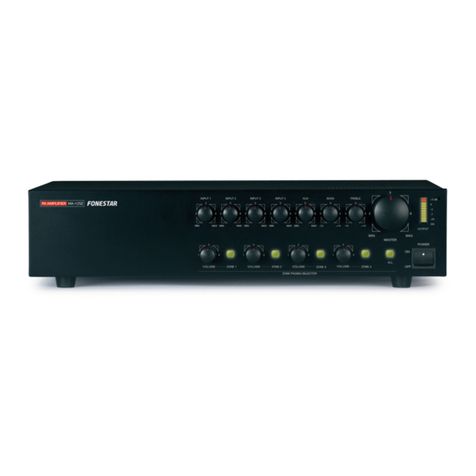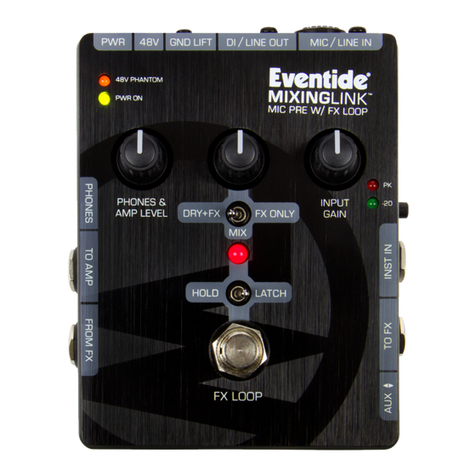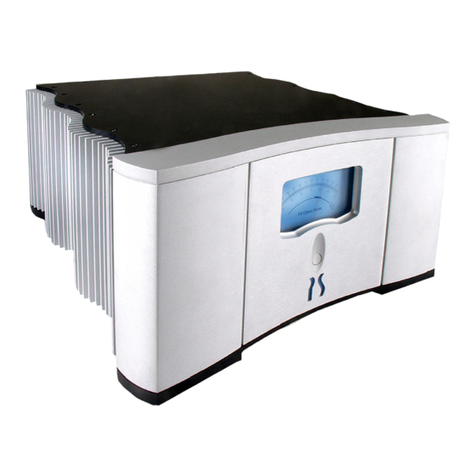VM Audio ECD1200.1 User manual

ECD1200.1 / ECD1500.1 / ECD2500.1
ECD3300.1 / ECD4200.1 / ECD5400.1
MONO AMPLIFIERS

CONTENTS
INTRODUCTION
FEATURES
FUNCTIONS
GETTING STARTED
INSTALLATION
POWER CONNECTIONS
AUDIO INPUT
LINE OUTPUT
REMOTE CONNECTION
SPEAKER WIRING
CONTROLS
CALIBRATION
TROUBLESHOOTING
SPECIFICATIONS
WARRANTY
2
2
3
5
7
8
12
13
14
15
18
19
21
23
25

2
INTRODUCTION
You have just purchased a product from VM Audio’s
Encore Series. As one who demands only the best from
what life offers, you expect luxury and comfort from
your purchasing choice. The Encore Series is designed
to satisfy that need and continue to impress. From
years of experience and unending passion, the experts
at VM Audio have meticulously designed and tested
each product to ensure sounds so true and so clear, it
feels like a live performance. Please read through the
installation instructions and follow carefully; ask for the
help of a certied installer if necessary. When properly
installed, the Encore Series product will perform at its
optimum presentation awlessly for years to come. The
professionals hear what was intended by the artists;
now, so can you.
• Mono Power Subwoofer Car Amplier
• Hyper-Digital Class D Design
• Exclusive High-Cycle DC-to-DC PWM Conversion
• Sophisticated Noise Free Single Star Ground System
• Low Noise Buffered Line Level Input Stage
• Ultra Low Distortion Multi-Stage Signal Processing
• Regulated Synergistic High Voltage Rail Performance
• Side-to-Side Air Flow Thermal Cooling Ventilation
• Second Order Linkwitz Riley Active Filter Processing
• Efcient High Power Switch-Mode Amplier Stage
• SelfGuard Protection
• Turn-On Outow Limiting Current (VM Audio exclusive)
FEATURES

3
FUNCTIONS
Front Panel
1. INPUT: Audio Cable Jack Connections
2. OUTPUT: Audio Cable Jack Connections
3. GAIN: Signal Strength Level Adjustment
4. LPF: Low-Pass Frequency Filter Setting
5. SUBSONIC: High-Pass Filter Setting
6. BASS FREQ: Low-Pass Filter Setting
7. BASS BOOST: Bass Adjustment Knob
8. BASS REMOTE: Remote Jack Connection
9. POWER LED: Power Status Notication
10. PROTECTION LED: Protection Notication
12
3 4 567
8
9
10

4
Rear Panel
11. SPEAKER OUTPUT: Speaker Wire Terminals
12. FUSE: In-Line Protection Fuses
13. POWER INPUT: Power Cable Terminals
11 13
12

Mounting
• Mount the amplier on a at, secure surface.
• Investigate the layout of your automobile
thoroughly before drilling.
• Place the amplier in a location that allows air to
circulate around it to keep it cool.
• If possible, mount the amplier vertically for
proper heat dissipation.
• Avoid mounting the amplier upside-down as
this will not provide adequate ventilation for the
amplier.
• In order to prevent overheating, avoid covering
the amplier with carpet or enclosing it behind
the interior panels.
• If the amplier is installed in a tight area, it must
have at least a 1-inch air gap all around for
proper cooling.
Warning!
• Be aware of gas tanks, gas lines, hydraulic lines
and electrical wiring when drilling mounting holes
to prevent serious or life threatening injuries.
• Do not leave the amplier unmounted in order to
prevent the unit from ejecting like a projectile in
the unexpected event of an accident.
• Do not mount the amplier on top of wires or
metal surfaces in order to prevent electrical
short circuit or a re.
• Never mount the amplier in the engine
compartment.
5
GETTING STARTED

6
Wiring
• Before you begin routing and connecting the
power wires, disconnect the negative ground
cable from the vehicle’s battery.
• Install and connect the highest possible wire
gauge the amplier’s terminal will accept (1/0
GAUGE) for both power cables (+12V and GND).
• Install an in-line fuse into the positive (+) wire 18
inches away from the car battery. It should be
the same rating as the amplier’s internal fuse(s)
• Route all power and speaker wires inside the
vehicle toward the amplier prior to mounting it.
• Avoid routing electrical wires where they are at
risk of getting pinched.
• Use rubber or plastic grommets to protect any
wires when routed through metal.
• Route the power cables through one side of
the vehicle while routing the RCA audio cables
through the other side.
• The ground connections should be as short as
possible and always be connected to chassis
metal. Chassis ground connection should be
clean, rust free, unpainted and as close to the
amplier as possible.
Warning!
• Disconnect the negative (-) battery terminal
before routing cables and wires to prevent
electrical shorts.
• Never route wires underneath the vehicle.
• Do not run wires through sharp edges.
• Always turn off amplier(s) before making any
type of connection.

7
INSTALLATION
12
3
Mark the mounting
screw holes to be
drilled with a marker.
WARNING! Be aware of gas tanks, gas lines, hydraulic
lines and electrical wiring when drilling mounting holes
to prevent serious or life-threatening injuries.
Drill the holes on the
marked spots with an
electric drill.
Secure the amplier
with screws using a
phillips screwdriver.
Make sure to mount the amplier in a location
where there is enough room to have access to the
knobs and terminals.

8
POWER CONNECTIONS
Before you begin, carefully remove the speaker
and power terminal end cap from the amplier by
removing all ve screws.
Prepare the terminals to connect the cables and
wires by loosening and backing out all screws
from the power and speaker terminals.

1. Strip 1/2 inch of insulation off each end of the
power cables used.
2. Install an in-line fuse holder 18 inches away from
the car battery.
3. Connect the Battery terminal to the in-line fuse
using a short power cable.
4. Route another power cable from the in-line
fuse to the amplier’s power terminal (or a power
capacitor such as VM Audio SRCAP3.0).
5. Connect the power cable to the in-line fuse
and the other end to the amplier’s positive +12V
power terminal (or capacitor’s positive +terminal).
6. Re-install the end cap to the amplier.
Power
Battery
Terminal
In-Line
Fuse
Capacitor
Power
Terminal
VM Audio SRS44B power kit
recommended
Disconnect the negative (-) battery terminal
before routing wires to prevent electrical shorts.
POWER CONNECTIONS continued...
9

9
1. Locate the remote wire on the stereo head unit.
2. Route the remote wire with a wire length that
expands from the stereo head unit all the way to
the amplier’s negative power terminal.
3. Strip both ends of the remote wire by 1/2” to
expose the wire.
4. Connect the remote wire to the stereo’s
remote wire by twisting both wires together, and
insulate the connection well with electrical tape.
5. Connect the other end of the remote wire to
the amplier’s remote REM terminal.
REMOTE
The remote wire, when connected to the amplier, is
designed to turn on the amplier automatically when
your stereo is turned on.
Consult with the manufacturer’s user guide for your
stereo head unit to locate the remote or turn-on wire,
as some manufacturers might label their amplier
turn-on feature differently.
10

10
For a good electrical connection and maximum power
transfer, use the same gauge size ground cable as
the power cable. The length of the cable should be
as short as possible and as close to the amplier as
possible.
GROUND
1. Locate a good, non-rusted chassis metal point
in the vehicle.
2. Mark and drill a screw hole with an electric drill
where chassis ground connection is to be made.
3. Use sandpaper to remove paint or rust to
expose the area to bare metal.
4. Strip 1/2” of insulation on both ends of the
ground cable to expose the wires.
5. Connect one end of the ground cable to an
O-ring connector, and tightly fasten the connector
using a sheet metal screw to the chassis metal.
6. Connect the other end of the gound cable to
the amplier’s ground GND terminal.
WARNING! Be aware of gas tanks, gas lines, hydraulic
lines and electrical wiring when drilling mounting holes
to prevent serious or life-threatening injuries.
POWER CONNECTIONS continued...
11

11
AUDIO INPUT
The audio inputs on the side panel of the amplier
receive low level signals from the RCA outputs
of the stereo head unit. If your stereo head unit
does not have RCA outputs, a High-to-Low level
converter (not included) must be used. Both line
inputs need to be connected to the stereo head
unit in order to use all of the speaker outputs.
Stereo RCA Cables
Speaker Wires
High-to-Low Level
Converter
(not included)
Left
Channel
Right
Channel
Right
Channel
Left
Channel
12

12
LINE OUTPUT
Linking
Amplier
The pre-amp line outputs allow linking additional
ampliers without the need to split the audio signals
from the stereo, using Y-RCA cable adaptors.
Amplier Line Outputs
Main
Amplier
13

13
REMOTE CONNECTION
The remote control knob will allow you to control the
bass output from your dashboard.
Remote Cable Plug-in
Remote
Bass Knob
Remote Plug
on Amplier
1. Carefully route the cable (included) from
the amplier to your stereo head unit.
2. Once the cable is in place, connect one
end of the cable to the remote bass knob.
3. Connect the other end of the cable to
the amplier remote plug input.
14

14
SPEAKER WIRING
Single Subwoofer Wiring
Connect the subwoofer’s positive +terminal to the
positive +terminal on the amplier, then connect the
negative (-) terminal of the subwoofer to the negative
(-) terminal on the amplier.
30 Hz
Amplier Filter Setting
1Ω MINIMUM
SPEAKER
IMPEDANCE
80 Hz
15

15
Parallel Subwoofer Wiring
80 Hz
Amplier Filter Setting
1
2
Connect the positive +terminals from subwoofers 1
and 2 to the positive +terminal on the amplier, then
connect the negative (-) terminals from subwoofers 1
and 2 to the negative (-) terminal on the amplier.
2Ω MINIMUM
ON EACH
SPEAKER
30 Hz
16

Series Subwoofer Wiring
Connect subwoofer 1 positive +terminal to the negative
(-) terminal on subwoofer 2, then connect the negative
(-) terminal of subwoofer 1 to the negative (-) terminal on
the amplier. Connect subwoofer 2 positive +terminal to
the positive +terminal on the amplier.
2
1
0.5Ω MINIMUM
ON EACH
SPEAKER
80 Hz
Amplier Filter Setting
30 Hz
SPEAKER WIRING
17

17
CONTROLS
Description
Gain: This feature controls the audio input
signal strength going into the amplier.
Bass Boost: Increases the bass level from
+1dB up to +12dB.
LPF Frequency: Electronic lter that blocks
high frequency signals.
REMOTE: Gain knob cable input plug to
conveniently adjust the bass boost strength.
Power LED: Power and protection amplier
status indicator.
Input: Line level audio inputs.
Output: Line level audio outputs.
40Hz 180Hz
40Hz 180Hz
40Hz 180Hz
Subsonic: Bass lter that blocks the ultra
low frequencies.
Bass Frequency: Boost frequency
adjustment.
40Hz 180Hz
40Hz 180Hz
18

18
CALIBRATION
Setting Gain
1. Turn the gain and bass control all the way
down (counterclockwise).
2. Turn the vehicle on, and make sure the source
unit is turned on.
3. Insert a CD/DVD with undistorted music.
4. Begin increase the volume at the source until
you hear distortion (aproximately at 90%).
5. Turn the volume down at the source unit until
the distortion goes away.
6. At the amplier, slowly turn the Gain control
up (clockwise) until you hear a slight audio
distortion.
7. Turn the Gain control back down until the audio
distortion goes away.
8. When the Gain control is properly set, you
should be able to achieve the maximum
undistorted output with the volume turned all
the way up.
Warning!
Do not set the amplier’s gain very high as noise,
distortion and amplier heat will increase signicantly
and amplier failure could occur.
If Bass Boost is used, keep the Gain setting down.
19
This manual suits for next models
5
Table of contents
Other VM Audio Amplifier manuals
